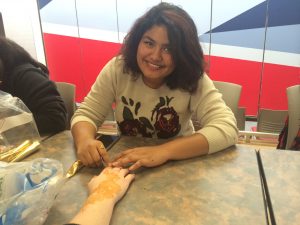By Dariya Baiguzhiyeva [3]
BELLEVILLE – Floral ornaments, spirals and intricate lines form a beautiful pattern on hands of Loyalist students. For many of them, these are just henna tattoos. For international students from India, this is a way to connect with their culture.
During the Universal Break [4] on Wednesday, the admissions office at Loyalist College together with the international office provided a henna tattoo session, led by four international students from India. Taksharya Brahmbhatt was one of them.
 [5]
[5]Taksharya Brahmbhatt learnt to henna tattoos by herself. Photo by Dariya Baiguzhiyeva, QNet News.
An 18- year old biotechnology student from Gujarat, India, Brahmbhatt said she had recently started doing henna tattoos. For her, it is a way of showing her creativity and expressing herself.
“I watched people doing it in my country. I just used to admire that, then I started painting myself,” she said. “Throughout time I got more chance to make it.”
Henna [6] is a flowering plant that can be found in South Asia, North Africa and Middle East. The earliest use of the plant goes back to the ancient Egypt. Nowadays, mehndi, the paste taken from the powdered leaf of the plant, is used for dying hair, skin and fingernails. It can be done in different colours, such as black, pink, purple and blue.
Brahmbhatt said that in India mehndi is used for special occasions, such as weddings, ring ceremonies or baby showers. Henna can either be made or bought.
“It’s based off the plant. We have to dry it, it’s a tedious process, but we have to dry it and mix it up with the water. Then we can make plastic cones and we can fill them.”
Brahmbhatt does not plan to stop doing henna tattoos and together with her friend even wants to open a business of henna making.
“Henna catches you from the roots of your culture,” she said.
Heather Vitkuske, an international student integration support officer, said that the event is popular among students. If it is successful, they will continue holding such events.
“We had this activity in the past and it was popular. It is a way for international students to share their culture and teach their traditions.”
Vitkuske said that the international office provided all necessary supplies for mehndi.
“The henna that is used is directly from India. It’s an authentic henna.”

